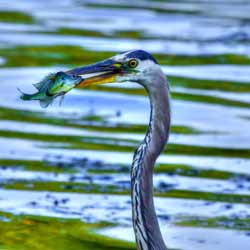US Fish & Wildlife Aids and Technicians
The U.S. Fish and Wildlife Service, a division of the U.S. Department of the Interior, offers seasonal work to young professionals and students who want to gain experience working with natural habitats and animal populations.

These positions are ideal for students and recent grads who want to spend a summer in the great outdoors – or start off a lifelong career in conservation services.
The goal of the Fish & Wildlife Service is to protect animals and their natural habitats. A typical day might include measuring trees, counting livestock, building or repairing roads or maintaining trails in a park or wildlife preserve. Seasonal work is offered in a wide range of settings, including field stations, wild animal refuges and research stations. There are volunteer positions available in nearly every state, and while many are in remote wilderness areas, many others are located close to or in major cities.
Did You Know? The U.S. Fish and Wildlife Service is the principal federal agency overseeing the protection of habitats for over 800 different bird species that live or migrate within the United States.
The U.S. Fish & Wildlife Service Seasonal Job Descriptions
When you work with a conservation service like the U.S. Fish & Wildlife Service, there’s never a “typical day.” Duties, responsibilities and activities will often vary from day to day – or even hour to hour, depending on weather conditions and other unpredictable factors. There are, however, general job descriptions for some of the most popular seasonal positions with the Fish & Wildlife Service.
- Forestry Aides & Technicians perform many different duties related to forestry, and may spend days or weeks in the backcountry away from others. They may be posted as firewatchers at campgrounds and in parks where camping is allowed, or help maintain healthy forests by thinning trees, recording growth and compiling other important data.
- Range Aides and Technicians help maintain public land that has wild game and livestock. Their activities support growth among the populations living there. They count livestock, protects its range, develop land and build and fix fences, as well as inspect land for fire regulation compliances. In rare occasions aides are called into help out with fires.
- Surveying Aides and Technicians are members of surveying teams that inspect and survey the land. They can also be members of a road working crew. Work includes construction of new roads or new trails, marking new staked out routes and clearing growth around power lines.
- Biological Aides and Technicians usually work alongside biologists and professional naturalists who are conducting research. Projects might have aides and technicians working in fisheries or hatcheries or out in the field doing observation and compiling data for reports. Some of them even lead tours and give talks to help educate the public about local wildlife and habitat management programs.
- Physical Science Aides and Technicians assist scientists in their research into aspects of the physical sciences, including soil, rocks and minerals. The actual job duties may include recording and analyzing complex data, mixing solutions, working with technical equipment and running tests on various land formations.
Job requirements vary according to the needs of the job. Most positions require a mix of manual labor and scientific knowledge, though the ratio of physical ability to technical skill varies widely.
Did You Know? The U.S. has over 3,660,000 miles of rivers, of which roughly 600,000 miles are located beyond one or more of the nation’s 75,000 dams. That comprises only 17% of the U.S. river system.
Quick Summary:
- The main goal of the U.S. Fish and Wildlife Service is to protect animals and their natural environment.
- Jobs with the U.S. Fish & Wildlife Service are more science oriented and less social than jobs with many other park services.
- These are ideal jobs for individuals who want to see the country, but want to spend most of their time out in the wilderness.


 Teach English in Asia
Teach English in Asia  Cruise Ship Jobs
Cruise Ship Jobs  Alaska Fishing Industry Jobs
Alaska Fishing Industry Jobs  Sharing Economy / Gig Economy
Sharing Economy / Gig Economy